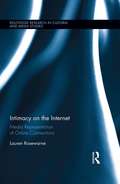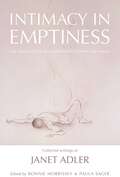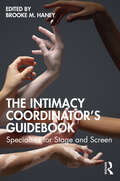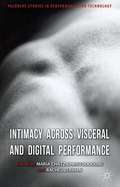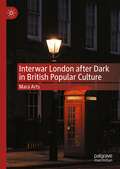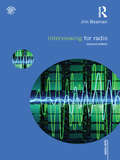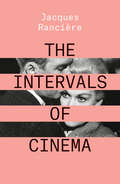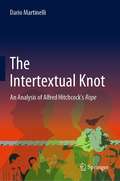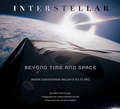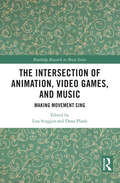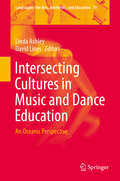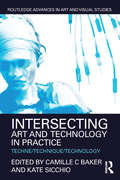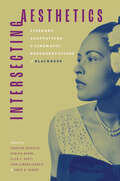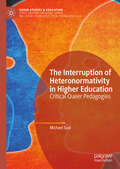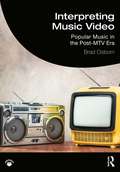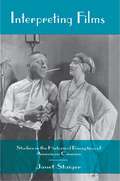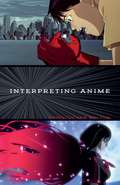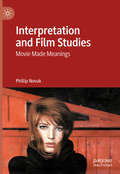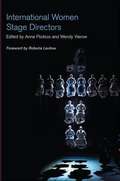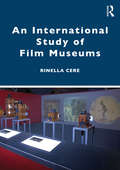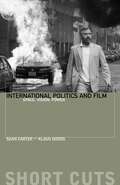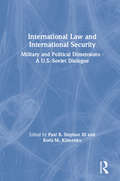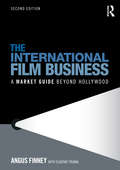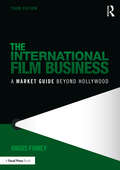- Table View
- List View
Intimacy on the Internet: Media Representations of Online Connections (Routledge Research in Cultural and Media Studies)
by Lauren RosewarneThe focus of this book is on the media representations of the use of the Internet in seeking intimate connections—be it a committed relationship, a hook-up, or a community in which to dabble in fringe sexual practices. Popular culture (film, narrative television, the news media, and advertising) present two very distinct pictures of the use of the Internet as related to intimacy. From news reports about victims of online dating, to the presentation of the desperate and dateless, the perverts and the deviants, a distinct frame for the intimacy/Internet connection is negativity. In some examples however, a changing picture is emerging. The ubiquitousness of Internet use today has meant a slow increase in comparatively more positive representations of successful online romances in the news, resulting in more positive-spin advertising and a more even-handed presence of such liaisons in narrative television and film. Both the positive and the negative media representations are categorised and analysed in this book to explore what they reveal about the intersection of gender, sexuality, technology and the changing mores regarding intimacy.
Intimacy in Emptiness: An Evolution of Embodied Consciousness
by Janet Adler• Offers insights from the author&’s 50-year study of the inner witness developing toward compassionate presence, intuitive knowing, and direct experience of the divine• Illuminates how commitment to this mystical practice supports participation in evolving consciousness within groups, grounded in personal healingThe Discipline of Authentic Movement, grounded in the relationship between a mover and a witness, connects us directly with the inner wisdom of the body. In the emptiness of the movement space, a mover&’s inner experience--feelings, sensations, images, and thoughts--become outer, unchoreographed gestures. Seen by their inner witness in the presence of an outer witness, the mover steps into the intimate mystery of who they are becoming. Sharing vivid examples from founder of the Discipline of Authentic Movement Janet Adler&’s 50-year inquiry, Intimacy in Emptiness brings her essential writings, including new and previously unpublished work, to a wider audience, guiding readers through the multiple layers of this experiential and innovative approach to embodied consciousness. Her writings illuminate the path of the developing inner witness, transforming toward compassionate presence, conscious speech, and intuitive knowing. This contemporary mystical practice, a breakthrough in the field of consciousness studies, includes personal healing as an essential base from which direct experience of the numinous can safely emerge, be witnessed, and become integrated into the fullness of the whole person. The emergence of the unique gesture and voice of each individual develops toward participation in consciously embodied groups. A new form of intelligence moves through collective bodies in service of healing in our world.
The Intimacy Coordinator's Guidebook: Specialties for Stage and Screen
by Brooke M. HaneyThe Intimacy Coordinator's Guidebook: Specialties for Stage and Screen explores the role of the intimacy choreographer with an in-depth look at specializations that exist within the profession.With contributions by over 30 industry professionals, this book aims to bring awareness to a wide range of needs a project may have and how intimacy professionals use their cultural competency specialists in practice to create the most compelling storytelling. In Part One, the book addresses the scope of practice of an intimacy professional by discussing competency, finding your lens and tangential fields in the industry like fight directors, mental health coordinators and cultural competency specialists. Part Two covers specialties like working with minors, prosthetics, intimacy and disability, staging queer intimacy, working with fat actors, Black American intimacy, dance, working on scenes of trauma, sexual violence and non-consent, and BDSM. Between each chapter is a conversation with an actor, director or producer on their experiences working with an intimacy coordinator. In Part Three, the book looks at what it means to be qualified and intimacy professionals' hopes for the future of the industry.The Intimacy Coordinator's Guidebook is an invaluable resource for directors and producers looking to hire an intimacy professional, as well as in-depth study for those who are training or practicing in the field of intimacy for performance.
Intimacy Across Visceral and Digital Performance
by Maria Chatzichristodoulou Rachel ZerihanConsisting of critical analyses, theoretical provocations and practical reflections by leading scholars/practitioners from the fields of performance studies, live art and creative technology, these essays examine the rise of intimate performance works and question the socio-historical contexts provoking those aesthetic and affective developments.
Interwar London after Dark in British Popular Culture
by Mara ArtsThis book explores the representation of London’s nightlife in popular films and newspapers of the interwar period. Through a series of case-studies, it analyses how British popular media in the 1920s and 1930s displayed the capital after dark. It argues that newspapers and films were part of a common culture, which capitalized on the transgressive possibilities of the night. At the same time both media ensured that those in authority, such as the police, were always shown to ultimately be in control of the night. The first chapter of the book provides an overview of the British film and newspaper industries in the interwar period. Subsequent chapters each explore a specific aspect of London’s nightlife. In turn, these chapters consider how films and newspapers of the interwar period depicted women navigating the street at night; the Metropolitan Police’s involvement in nightlife; and the capital’s newly built and expanded suburbs and public transport network. Finally, the book considers how newspapers and films depicted themselves and one another.
Interviewing for Radio (Media Skills)
by Jim Beaman'Jim Beaman’s Interviewing for Radio is a classic and seminal practice text, brilliantly written and masterful in its content. Nobody working in professional radio can do without it. It is a must for all radio courses and I could not recommend it more highly' - Tim Crook, Head of Radio, Goldsmiths College, University of London, UK Interviewing for Radio is a thorough introduction to the techniques and skills of the radio interview. It offers advice on how to ask the right question and elicit a response, and guides the reader through the use of equipment, the mechanics of recording, the studio environment, live broadcasts, presentation and pronunciation, and editing material. Written by an experienced producer and instructor, Interviewing for Radio includes: the history of the radio interview and the importance of its role today practical exercises which introduce successful interview and technical skills case studies and hypothetical scenarios to help you prepare for potential difficulties a discussion of ethics, risk assessment, codes of conduct and regulations This second edition has been thoroughly updated and includes advice from a new range of practitioners, and examples of recent UK and international interviews. The author critically analyses these interviews and explains the preparation, organisation and expertise required in order to produce a successful radio broadcast. Interviewing for Radio references both new and existing regulations and guidelines for UK journalists, then offers a global perspective by drawing on the differences and similarities with those applicable to other countries. This invaluable book is supported by a companion website that includes audio interviews with practitioners accompanied by a range of student exercises, a comprehensive glossary in the form of interactive flashcards, and suggested links for further listening.
The Intervals of Cinema
by John Howe Jacques RanciereCinema, like language, can be said to exist as a system of differences. In his latest book, acclaimed philosopher Jacques Rancière looks at cinematic art in comparison to its corollary forms in literature and theatre. From literature, he argues, cinema takes its narrative conventions, while at the same time effacing literature's images and philosophy; and film rejects theatre, while also fulfilling theatre's dream. Built on these contradictions, the cinema is the real, material space in which one is moved by the spectacle of shadows. Thus, for Rancière, film is the perpetually disappointed dream of a language of images.From the Trade Paperback edition.
The Intertextual Knot: An Analysis of Alfred Hitchcock’s Rope
by Dario MartinelliThis book is a thorough analysis of Alfred Hitchcock's Rope (1948) and of its multiple connections with the Leopold and Loeb murder case and the adaptation of Patrick Hamilton’s eponymous play. As an all-encompassing portrait of the movie, the book discusses its aesthetics, style, role within cinema history, challenges in production, innovations introduced and of course Hitchcock’s signature features. However, as the analysis unfolds, the film reveals itself as an actual journey through the nightmares and the hopes that characterized the 20th century. Nazism and anti-Nazism, antisemitism, homophobia, democracy and totalitarianism, capital punishment and second chances, human rights, World War II, misogyny, tolerance and discrimination, Supermanism and humanism, artistic freedom and censorship. Subtly, often between the lines, and with Hitchcock's usual dark humor, Rope is nevertheless a much stronger social and political statement than it was ever given credit for. The Intertextual Knot is aimed at a varied readership, including film scholars, historians, philosophers and film enthusiasts.
Interstellar: Beyond Time And Space
by Mark Cotta VazIn his sci-fi epic Interstellar, Christopher Nolan takes on the infinite canvas of space to deliver a cutting-edge, emotionally charged adventure that will amaze audiences of all ages. <P><P> Interstellar: Beyond Time and Space documents the making of Nolan's latest masterpiece in fascinating detail and features interviews with the acclaimed director, along with screenwriter Jonathan Nolan, producer Emma Thomas, and other key members of the production team. Delving into the science and philosophy behind the film, Interstellar: Beyond Time and Space dynamically showcases its incredible concept art, including costume designs, storyboards, and other fascinating preproduction elements. Also featuring interviews with the exceptional cast, including Matthew McConaughey and Anne Hathaway, Interstellar: Beyond Time and Space tells the full story of the making of the film, with candid pictures illustrating its elaborate set pieces and reliance on classic special effects techniques. Visually enthralling and engrossing in its in-depth exploration of the themes and ideas at the heard of Interstellar, this book is the perfect accompaniment to one of the most anticipated films of 2014. Based on the film from Warner Bros. Pictures and Paramount Pictures. From acclaimed filmmaker Christopher Nolan ("The Dark Knight" films, "Inception"), "Interstellar" stars Oscar winner Matthew McConaughey ("Dallas Buyers Club"), Oscar winner Anne Hathaway ("Les Miserables"), Oscar nominee Jessica Chastain ("Zero Dark Thirty"), Bill Irwin ("Rachel Getting Married"), Oscar winner Ellen Burstyn ("Alice Doesn't Live Here Anymore"), and Oscar winner Michael Caine ("The Cider House Rules"). The main cast also includes Wes Bentley, Casey Affleck, David Gyasi, Mackenzie Foy and Topher Grace. Christopher Nolan directed the film from a screenplay he co-wrote with Jonathan Nolan. Emma Thomas, Christopher Nolan and Lynda Obst produced "Interstellar," with Jordan Goldberg, Jake Myers, Kip Thorne and Thomas Tull serving as executive producers. Warner Bros. Pictures and Paramount Pictures present, in association with Legendary Pictures, a Syncopy/Lynda Obst Productions production, a film by Christopher Nolan, "Interstellar. " INTERSTELLAR and all related characters and elements are trademarks of and © Warner Bros. Entertainment Inc. (s14)
The Intersection of Animation, Video Games, and Music: Making Movement Sing (Routledge Research in Music)
by Lisa Scoggin and Dana PlankIn both video games and animated films, worlds are constructed through a combination of animation, which defines what players see on the screen, and music and sound, which provide essential cues to action, emotion, and narrative. This book offers a rich exploration of the intersections between animation, video games, and music and sound, bringing together a range of multidisciplinary lenses. In 14 chapters, the contributors consider similarities and differences in how music and sound structure video games and animation, as well as the animation within video games, and explore core topics of nostalgia, adaptation, gender, and sexuality. Offering fresh insights into the aesthetic interplay of animation, video games, and sound, this volume provides a gateway into new areas of study that will be of interest to scholars and students across musicology, animation studies, game studies, and media studies more broadly.
Intersecting Cultures in Music and Dance Education
by Linda Ashley David LinesThis volume looks forward and re-examines present day education and pedagogical practices in music and dance in the diverse cultural environments found in Oceania. The book also identifies a key issue of how teachers face the prospect of taking a reflexive view of their own cultural legacy in music and dance education as they work from and alongside different cultural worldviews. This key issue, amongst other debates that arise, positions Intersecting Cultures as an innovative text that fills a gap in the current market with highly appropriate and fresh ideas from primary sources. The book offers commentaries that underpin and inform current pedagogy and bigger picture policy for the performing arts in education in Oceania, and in parallel ways in other countries.
Intersecting Art and Technology in Practice: Techne/Technique/Technology (Routledge Advances in Art and Visual Studies)
by Camille C Baker and Kate SicchioThis book focuses on the artistic process, creativity and collaboration, and personal approaches to creation and ideation, in making digital and electronic technology-based art. Less interested in the outcome itself – the artefact, artwork or performance – contributors instead highlight the emotional, intellectual, intuitive, instinctive and step-by-step creation dimensions. They aim to shine a light on digital and electronic art practice, involving coding, electronic gadgetry and technology mixed with other forms of more established media, to uncover the practice-as-research processes required, as well as the collaborative aspects of art and technology practice.
Intersecting Aesthetics: Literary Adaptations and Cinematic Representations of Blackness
by Charlene Regester, Cynthia Baron, Ellen C. Scott, Terri Simone Francis, and Robin G. VanderContributions by Cynthia Baron, Elizabeth Binggeli, Kimberly Nichele Brown, Priscilla Layne, Eric Pierson, Charlene Regester, Ellen C. Scott, Tanya L. Shields, and Judith E. Smith Intersecting Aesthetics: Literary Adaptations and Cinematic Representations of Blackness illuminates cultural and material trends that shaped Black film adaptations during the twentieth century. Contributors to this collection reveal how Black literary and filmic texts are sites of negotiation between dominant and resistant perspectives. Their work ultimately explores the effects racial perspectives have on film adaptations and how race-inflected cultural norms have influenced studio and independent film depictions. Several chapters analyze how self-censorship and industry censorship affect Black writing and the adaptations of Black stories in early to mid-twentieth-century America. Using archival material, contributors demonstrate the ways commercial obstacles have led Black writers and white-dominated studios to mask Black experiences. Other chapters document instances in which Black writers and directors navigate cultural norms and material realities to realize their visions in literary works, independent films, and studio productions. Through uncovering patterns in Black film adaptations, Intersecting Aesthetics reveals themes, aesthetic strategies, and cultural dynamics that rightfully belong to accounts of film adaptation. The volume considers travelogue and autobiography sources along with the fiction of Black authors H. G. de Lisser, Richard Wright, Ann Petry, Frank Yerby, and Walter Mosley. Contributors examine independent films The Love Wanga (1936) and The Devil’s Daughter (1939); Melvin Van Peebles's first feature, The Story of a Three Day Pass (1967); and the Senegalese film Karmen Geï (2001). They also explore studio-era films In This Our Life (1942), The Foxes of Harrow (1947), Lydia Bailey (1952), The Golden Hawk (1952), and The Saracen Blade (1954) and post-studio films The Learning Tree (1969), Shaft (1971), Lady Sings the Blues (1972), and Devil in a Blue Dress (1995).
The Interruption of Heteronormativity in Higher Education: Critical Queer Pedagogies (Queer Studies and Education)
by Michael SealThis book examines how heteronormativity in higher education can be interrupted and resisted. Located within the theoretical framework of queer and critical pedagogy and based on extensive empirical research, the author explores the dynamics of heteronormativity and its interruption on professional courses in a range of higher education institutions. Reactions to attempt to interrupt it were nuanced: while strategies of contested engagement, avoidance and retreat were expressed, heterosexualities were largely un-examined and un-articulated. ‘Coming out’ needs to be a pedagogical act, carried out concurrently with the interruptions of other social constructions and binary oppositions. The author calls for co-created and co-held meta-reflexive and liminal spaces that emphasise inter-subjectivity, encounters, and working in the moment. These spaces must de-construct and reconstruct pedagogical power and knowledge to promote collective intersubjective consciousnesses, and widen the vision of the reflective practitioner to that of the pedagogical practitioner. This pioneering book is a call to action to all those concerned with interrupting and problematising presumed binary categories of sexuality within the heterosexual matrix.
Interpreting Music Video: Popular Music in the Post-MTV Era
by Brad OsbornInterpreting Music Video introduces students to the musical, visual, and sociological aspects of music videos, enabling them to critically analyze a multimedia form with a central place in popular culture. With highly relevant examples drawn from recent music videos across many different genres, this concise and accessible book brings together tools from musical analysis, film and media studies, gender and sexuality studies, and critical race studies, requiring no previous knowledge. Exploring the multiple dimensions of music videos, this book is the perfect introduction to critical analysis for music, media studies, communications, and popular culture.
Interpreting Films: Studies in the Historical Reception of American Cinema
by Janet StaigerEmploying a wide range of examples from Uncle Tom's Cabin and Birth of a Nation to Zelig and Personal Best, Janet Staiger argues that a historical examination of spectators' responses to films can make a valuable contribution to the history, criticism, and philosophy of cultural products. She maintains that as artifacts, films do not contain immanent meanings, that differences among interpretations have historical bases, and that these variations are due to social, political, and economic conditions as well as the viewers' constructed images of themselves. After proposing a theory of reception study, the author demonstrates its application mainly through analyzing the varying responses of audiences to certain films at specific moments in history. Staiger gives special attention to how questions of class, gender, sexual preference, race, and ethnicity enter into film viewers' interpretations. Her analysis reflects recent developments in post-structuralism, cognitive psychology, psychoanalysis, and cultural studies, and includes a discussion of current reader-response models in literary and film studies as well as an alternative approach for thinking about historical readers and spectators.
Interpreting Anime
by Christopher BoltonFor students, fans, and scholars alike, this wide-ranging primer on anime employs a panoply of critical approaches Well-known through hit movies like Spirited Away, Akira, and Ghost in the Shell, anime has a long history spanning a wide range of directors, genres, and styles. Christopher Bolton’s Interpreting Anime is a thoughtful, carefully organized introduction to Japanese animation for anyone eager to see why this genre has remained a vital, adaptable art form for decades.Interpreting Anime is easily accessible and structured around individual films and a broad array of critical approaches. Each chapter centers on a different feature-length anime film, juxtaposing it with a particular medium—like literary fiction, classical Japanese theater, and contemporary stage drama—to reveal what is unique about anime’s way of representing the world. This analysis is abetted by a suite of questions provoked by each film, along with Bolton’s incisive responses.Throughout, Interpreting Anime applies multiple frames, such as queer theory, psychoanalysis, and theories of postmodernism, giving readers a thorough understanding of both the cultural underpinnings and critical significance of each film. What emerges from the sweep of Interpreting Anime is Bolton’s original, articulate case for what makes anime unique as a medium: how it at once engages profound social and political realities while also drawing attention to the very challenges of representing reality in animation’s imaginative and compelling visual forms.
Interpretation and Film Studies: Movie Made Meanings
by Phillip NovakThis book argues that the sustained interpretation of individual movies has, contrary to conventional wisdom, never been a major preoccupation of film studies—that, indeed, the field is marked by a dearth of effective, engaging, and enlightening critical analyses of single films. The book makes this case by surveying what has been written about four historically important and well-known movies (D. W. Griffith’s Way Down East, Marcel Carné’s Port of Shadows, Mike Nichols’s The Graduate, and Michelangelo Antonioni’s Red Desert), none of which has been the focus of sustained critical attention, and by exhaustively examining the kinds of work published in four influential film journals (Cinema Journal, Screen, Wide Angle, and Movie). The book goes on to argue for the value of the work of interpretation, illustrating this value through extended analyses of Roman Polanski’s Chinatown and Christopher Nolan’s Memento, both of which thematize interpretation. Novak demonstrates the causes and consequences of reading poorly and the importance of reading well.
International Women Stage Directors
by Wendy Vierow Anne FliotsosA fascinating study of women in the arts, International Women Stage Directors is a comprehensive examination of women directors in twenty-four diverse countries. Organized by country, chapters provide historical context and emphasize how social, political, religious, and economic factors have impacted women's rise in the theatre, particularly in terms of gender equity. Contributors tell the stories of their home country's pioneering women directors and profile the most influential women directors practicing today, examining their career paths, artistry, and major achievements. Contributors are Ileana Azor, Dalia Basiouny, Kate Bredeson, Mirenka Cechová, Marié-Heleen Coetzee, May Farnsworth, Anne Fliotsos, Laura Ginters, Iris Hsin-chun Tuan, Maria Ignatieva, Adam J. Ledger, Roberta Levitow, Jiangyue Li, Lliane Loots, Diana Manole, Karin Maresh, Gordon McCall, Erin B. Mee, Ursula Neuerburg-Denzer, Claire Pamment, Magda Romanska, Avra Sidiropoulou, Margaretta Swigert-Gacheru, Alessandra Vannucci, Wendy Vierow, Vessela S. Warner, and Brenda Werth.
An International Study of Film Museums
by Rinella CereAn International Study of Film Museums examines how cinema has been transformed and strengthened through museological and archival activities since its origins and asks what paradoxes may be involved, if any, in putting cinema into a museum. Cere explores the ideas that were first proposed during the first half of the twentieth century around the need to establish national museums of cinema and how these have been adapted in the subsequent development of the five case studies presented here: four in Europe and one in the USA. The book traces the history of the five museums' foundation, exhibitions, collections, and festivals organised under their aegis and it asks how they resolve the tensions between cinema as an aesthetic artefact – now officially recognised as part of humanity's cultural heritage – and cinema as an entertainment and leisure activity. It also gives an account of recent developments around unifying collections, exhibition activities and archives in one national film centre that offers the general public a space totally devoted to film and cinematographic culture. An International Study of Film Museums provides a unique comparative study of museums of cinema in varying national contexts. The book will be of interest to academics and students around the world who are engaged in the study of museums, archives, heritage, film, history and visual culture.
International Politics and Film
by Sean CarterInternational Politics and Film introduces readers to the representational qualities of film but also draws attention to how the relationship between the visual and the spatial is constitutive of international politics. Using four themes -- borders, the state of exception, homeland and distant others -- the territorial and imaginative dimensions of international affairs in particular are highlighted. But theis volume also makes clear that international politics is not just something 'out there'; film helps us better understand how it is also part of everyday life within the state -- affecting individuals and communities in different ways depending on axes of difference such as gender, race, class, age, and ethnicity.
International Politics and Film: Space, Vision, Power (Short Cuts)
by Klaus Dodds Sean CarterInternational Politics and Film introduces readers to the representational qualities of film but also draws attention to how the relationship between the visual and the spatial is constitutive of international politics. Using four themes—borders, the state of exception, homeland and distant others—the territorial and imaginative dimensions of international affairs in particular are highlighted. But this volume also makes clear that international politics is not just something "out there"; film helps us better understand how it is also part of everyday life within the state—affecting individuals and communities in different ways depending on axes of difference such as gender, race, class, age, and ethnicity.
International Law and International Security: Military and Political Dimensions - A U.S.-Soviet Dialogue
by Paul B. Stephan, III Boris M. KlimenkoThis volume brings together experts and political actors from the United States and the USSR to assess the status of international law in the post-Cold War era with the intention of contributing ideas, judgements, and proposals tempered by experience. The topics covered range from terrorism to peaceful conflict resolution; from the renunciation of aggression to the right of self-defence; from chemical, biological, and nuclear weapons limitations to problems of verification; and from the military use of space to the right of political self-determination. Each chapter features contributions by both US and Soviet experts who have themselves participated in high-level policy making and international negotiations in the area (including, for example, the ABM, SALTI, SALTII, CFE, and START talks).
The International Film Business: A Market Guide Beyond Hollywood
by Angus FinneyThe International Film Business examines the independent film sector as a business, and addresses the specific skills and knowledge it demands. It describes both the present state of the industry, the significant digital and social media developments that are continuing to take place, and what changes these might effect. The International Film Business: describes and analyses the present structure of the film industry as a business, with a specific focus on the film value chain discusses and analyses current digital technology and how it potentially may change the structure and opportunities offered by the industry in the future provides information and advice on the different business and management skills and strategies includes case studies on a variety of films including The Guard (2011), The King’s Speech (2010), The Best Exotic Marigold Hotel (2012), Cloverfield (2008), Pobby & Dingan (aka Opal Dream, 2005), Confessions of a Dangerous Mind (2002), The Reckoning (2002)and The Mother (2003), and company case studies on Pixar, Renaissance, Redbus and Zentropa. Further case studies on films that failed to go into production include Neil LaBute’s Vapor and Terry Gilliam’s Good Omens. Taking an entrepreneurial perspective on what future opportunities will be available to prepared and informed students and emerging practitioners, this text includes case studies that take students through the successes and failures of a variety of real film companies and projects and features exclusive interviews with leading practitioners in all sectors of the industry, from production to exhibition.
The International Film Business: A Market Guide Beyond Hollywood
by Angus FinneyExamining the independent film sector as a business on an international scale, author Angus Finney addresses the specific skills and knowledge required to successfully navigate the international film business. Finney describes and analyses the present structure of the film industry as a business, with a specific focus on the film (and entertainment) value chain and takes readers through the status of current digital technology, exploring ways in which this is changing the structure and opportunities offered by the industry in the future. The textbook provides information and advice on the different business and management skills and strategies that students and emerging practitioners will need to effectively engage with the industry in an international context. Case studies of films and TV, including Squid Game (2021), Parasite (2019), Game of Thrones (2011-2019) and The Best Exotic Marigold Hotel (2011), are supplemented by company case studies on Redbus, Renaissance, Pixar, with additional new chapters focusing on Netflix, TikTok and the Metaverse. This third edition of The International Film Business includes up-to-date information on the status of the international film industry during and post COVID-19; expanded content looking at the TV industry and streaming services; new case studies and dedicated sections on the Streaming Wars and the Chinese Film Industry and a new chapter looking at the changes in digital production in the context of the global and territorial film and TV industry. Written for students of Film Business and emerging practitioners, this book will take readers through the successes and failures of a variety of real film companies and projects and features exclusive interviews with leading practitioners in all sectors of the industry, from production to exhibition.
